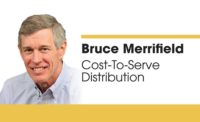
Anyone who is occupationally affected by, or intrigued with, the rapid increase in global PLP sales should carefully read the book, “Private Label Strategy: How to Meet the Store Brand Challenge.” (Published January 2007; authors: Kumar and Steenkamp.) This well-researched, well-written and comprehensive book focuses on the global best practices for consumer PLPs or “store brands.” But many of the book’s statistics, economic studies and summary guidelines can be readily applied to the accelerating sales of PLPs within commercial/industrial distribution channels in the U.S.
This article will summarize some of the book’s findings and then pose some questions for distribution-channel players to think about.
First, PLP sales are growing at the expense of manufacturers’ brands around the world:
PLP sales have shifted supply chain profit power to the retailers from the name-brand manufacturers.
Retailers have deployed a range of PLP brands:
The book has in-depth research on “price gap management,” which involves choosing the prices for both the competing brand name and store-brand items as they sit side by side on a shelf. The authors also point out that many retailers put too much emphasis on the better margin percentages that they get on store brands instead of focusing on “the profit dollars generated per square foot of space and duplicate inventory investment costs.”
Different studies in the book conclude that 50% of PLP brands are net losers from a profitability perspective, even though the store brands have higher margin percents built into their lower price.
How so? If, for example, a store brand is sold for a price that is 30% less than the name brand, while getting a 25% margin on the store brand vs. a 20% margin on the name brand, then the net margin dollars are less on the store brand per square foot. And the store now has at least twice the SKU/inventory costs.
Perhaps not wanting to admit that 50% of store brands are unprofitable, many executives reason that other factors more than offset the margin dollar per square foot problem. The most common rationalizations for too many store brands and SKUs are:
The authors cite studies that prove that the first two factors do have modest value, but the third is just hope.
Besides the 50% unprofitable store-brand item issue, the authors cover other pitfalls for store brands. The retailers that have gone beyond simple copycat product creation have backed into all of the marketing activities that the brand manufacturers have always done, such as: consumer research; product development; (sourcing/contracting) manufacturing, quality control and logistics; and advertising. Many retailers don’t do all of these activities as well as they need to, nor do the smaller chains have the economies of scale that name-brand manufacturers do with universal distribution volume, which in turn, supports the cost of advertising to build “imagery” value.
What should manufacturers do to counter the PLP growth trend?
The second half of the book is dedicated to answering this question. The chapter headings are:
To unfairly summarize all of these chapters: none of these “strategies” are easy, and PLP clones will continue to cherry-pick away at mature, unchanging branded items. Manufacturers will benefit from giving these chapters a careful read.
Closing observations and questions
1.Many wholesale-distributors and retailers of all sizes have sourced private label clones from Asian producers. Offering copycat products of the most popular, simple commodities at lower prices with fatter margin percents has usually resulted in quick “new” sales. But,a. What percent of these sales are to new customers as opposed to cannibalizing sales to old customers who were already buying the branded products that yielded almost the same total margin dollars (albeit at a lower margin percent times a higher price)?
b. With long supply lines from Asia, plus container quantity shipments, are the clones really turning and earning as well as we might think, with equal or better fill-rate satisfaction for customers that have switched from standard brands?
c. Even if the first wave of copycat products proves to be a winner using the more thorough total economic analysis from this article’s featured book, when will we cross the line into the 50% of PLP items that aren’t profitable? Could we develop a total math model to help us better define that breakeven zone?
d. What are the criteria for ranking which items should be cloned first to last? Should the criteria be modified and re-weighted for each new category of items and for each different segment of customers that a category might be sold to? If so, how? Is psycho-demographic analysis a core competency of the company?
e. As we source more items and do more repeat buys from Asian sources, how do we stay on top of those producers’ all-around reliability and economic efficiency? Should we consider outsourcing all of these problems to a firm like Li and Fung that has grown into a giant supply chain process manager for store brands at huge apparel chains and now has an “industrial division”?
2.In industrial/commercial channels the buyer of goods can often be different than the eventual internal user of the goods. As cost-controllers at headquarters declare new cost-cutting mandates on purchasing departments, the company’s internal users, who may be loyal to traditional brands, might be disappointed with private label alternatives.
a. Won’t the decision of whether to develop generic, copycat or premium PLPs be potentially very context- and customer-type specific? Distributors often sell products across a number of segments that may have different buying, brand-reaction patterns.
b. Because wholesalers, unlike retailers, can’t control retail traffic, shelf space, in-store advertising and product demonstrations, how should PLPs be sold to both purchasing people and commercial end-users to make up for the merchandising advantages that retailers have?
c. Could mimicking the PLP strategies from the world of retailers be less successful in a commercial/industrial distribution channel? Which ones and why?
In closing, the importance of making the right PLP decisions for all manufacturers, distributors and retailers will continue to grow. Our understanding of what has already happened in this area needs to catch up and stay on the leading edge. Thoroughly digesting and discussing the book, “Private Label Strategy,” is a first easy step. Meeting with the author(s), representatives from Li and Fung and the PLP teams from other progressive, noncompetitive distributors and retailers might be a good second step for what could be an important journey over the next five to 10 years. If any readers have interest or ideas about such a conference, please let me know.





